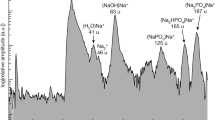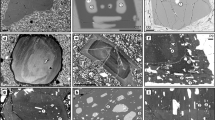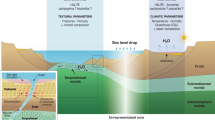Abstract
The discovery of water vapour and ice particles erupting from Saturn’s moon Enceladus fuelled speculation that an internal ocean was the source1,2,3. Alternatively, the source might be ice warmed, melted or crushed by tectonic motions4. Sodium chloride (that is, salt) is expected to be present in a long-lived ocean in contact with a rocky core. Here we report a ground-based spectroscopic search for atomic sodium near Enceladus that places an upper limit on the mixing ratio in the vapour plumes orders of magnitude below the expected ocean salinity5. The low sodium content of escaping vapour, together with the small fraction of salt-bearing particles6, argues against a situation in which a near-surface geyser is fuelled by a salty ocean through cracks in the crust1. The lack of observable sodium in the vapour is consistent with a wide variety of alternative eruption sources, including a deep ocean6, a freshwater reservoir, or ice. The existing data may be insufficient to distinguish between these hypotheses.
This is a preview of subscription content, access via your institution
Access options
Subscribe to this journal
Receive 51 print issues and online access
$199.00 per year
only $3.90 per issue
Buy this article
- Purchase on Springer Link
- Instant access to full article PDF
Prices may be subject to local taxes which are calculated during checkout



Similar content being viewed by others
References
Porco, C. C. et al. Cassini observes the active south pole of Enceladus. Science 311, 1393–1401 (2006)
Spencer, J. R. et al. Cassini encounters Enceladus: background and the discovery of a south polar hot spot. Science 311, 1401–1405 (2006)
McKay, C. P., Porco, C. C., Altheide, T., Davis, W. L. & Kral, T. A. The possible origin and persistence of life on Enceladus and detection of biomarkers in the plume. Astrobiology 8, 909–919 (2008)
Nimmo, F., Spencer, J. R., Pappalardo, R. T. & Mullen, M. E. Shear heating as the origin of the plumes and heat flux on Enceladus. Nature 447, 289–291 (2007)
Zolotov, M. Y. An oceanic composition on early and today's Enceladus. Geophys. Res. Lett. 34 L23203 10.1029/2007GL031234 (2007)
Postberg, F. et al. Sodium salts in E-ring ice grains from an ocean below the surface of Enceladus. Nature 10.1038/nature08046 (this issue)
Brown, R. A. in Exploration of the Planetary System (eds Woszczyk, A. & Iwaniszewska, C.) 527–531 (Proc. IAU Symp. No. 65, Reidel, 1974)
Brown, M. E. & Hill, R. E. Discovery of an extended sodium atmosphere around Europa. Nature 380, 229–231 (1996)
Potter, A. E. & Morgan, T. H. Discovery of sodium in the atmosphere of Mercury. Science 229, 651–653 (1985)
Potter, A. E. & Morgan, T. H. Discovery of sodium and potassium vapor in the atmosphere of the Moon. Science 241, 675–680 (1988)
Levin, B. J. On the reported Na tails of comets. Icarus 4, 497–499 (1964)
Lellouch, E., Paubert, G., Moses, J. I., Schneider, N. M. & Strobel, D. F. Volcanically emitted sodium chloride as a source for Io's neutral clouds and plasma torus. Nature 421, 45–47 (2003)
Vogt, S. S. et al. HIRES: the high resolution echelle spectrometer on the Keck 10-m telescope. Proc. SPIE 2198, 362–375 (1994)
Diego, F., Charalambous, A., Fish, A. C. & Walker, D. D. Final tests and commissioning of the UCL echelle spectrograph. Proc. SPIE 1235, 562–576 (1990)
Osterbrock, D. E. et al. Night-sky high-resolution spectral atlas of OH and O2 emission lines for echelle spectrograph wavelength calibration. Publ. Astron. Soc. Pacif. 108, 277–308 (1996)
Hansen, C. J. et al. Enceladus' water vapor plume. Science 311, 1422–1425 (2006)
Tian, F. et al. Monte Carlo simulations of the water vapor plumes on Enceladus. Icarus 188, 154–161 (2007)
Jurac, S. et al. Saturn: search for a missing water source. Geophys. Res. Lett. 29 2172 10.1029/2002GL015855 (2002)
Burger, M. H. Io's Neutral Clouds: From the Atmosphere to the Plasma Torus. Ph.D. thesis, Univ. Colorado (2003)
Burger, M. H. & Johnson, R. E. Europa’s neutral cloud: morphology and comparisons to Io. Icarus 171, 557–560 (2004)
Burger, M. H. et al. Understanding the escape of water from Enceladus. J. Geophys. Res. 112 A06219 10.1029/2002GL015855 (2007)
Kieffer, S. W. et al. A clathrate reservoir hypothesis for Enceladus' south polar plume. Science 314, 1764–1766 (2006)
Schmidt, J., Brillantov, N., Spahn, F. & Kempf, S. Slow dust in Enceladus' plume from condensation and wall collisions in tiger stripe fractures. Nature 451, 685–688 (2008)
Hunter Waite, J. et al. Cassini ion and neutral mass spectrometer: Enceladus plume composition and structure. Science 311, 1419–1422 (2006)
Acknowledgements
Some of the data presented here were obtained at the W.M. Keck Observatory, which is operated as a scientific partnership among the California Institute of Technology, the University of California and the National Aeronautics and Space Administration. The Observatory was made possible by the financial support of the W.M. Keck Foundation. We also acknowledge the Anglo-Australian Telescope and its staff. This work was supported by the National Science Foundation’s Planetary Astronomy Program and the NASA Postdoctoral Program. This paper has benefited from discussions with M. Zolotov, J. Spencer, C. Porco, T. Johnson, A. Ingersoll, W. McKinnon, C. Mackay, F. Postberg, J. Schmidt, S. Kempf and R. Pappalardo.
Author information
Authors and Affiliations
Corresponding author
Supplementary information
Supplementary Information
This file contains Supplementary Data and Notes and Supplementary References. (PDF 156 kb)
Rights and permissions
About this article
Cite this article
Schneider, N., Burger, M., Schaller, E. et al. No sodium in the vapour plumes of Enceladus. Nature 459, 1102–1104 (2009). https://doi.org/10.1038/nature08070
Received:
Accepted:
Issue Date:
DOI: https://doi.org/10.1038/nature08070
This article is cited by
-
Comparative Na and K Mercury and Moon Exospheres
Space Science Reviews (2022)
-
Dust Emission by Active Moons
Space Science Reviews (2018)
-
A salt-water reservoir as the source of a compositionally stratified plume on Enceladus
Nature (2011)
-
Mapping Magnetospheric Equatorial Regions at Saturn from Cassini Prime Mission Observations
Space Science Reviews (2011)
-
Surface, Subsurface and Atmosphere Exchanges on the Satellites of the Outer Solar System
Space Science Reviews (2010)
Comments
By submitting a comment you agree to abide by our Terms and Community Guidelines. If you find something abusive or that does not comply with our terms or guidelines please flag it as inappropriate.



